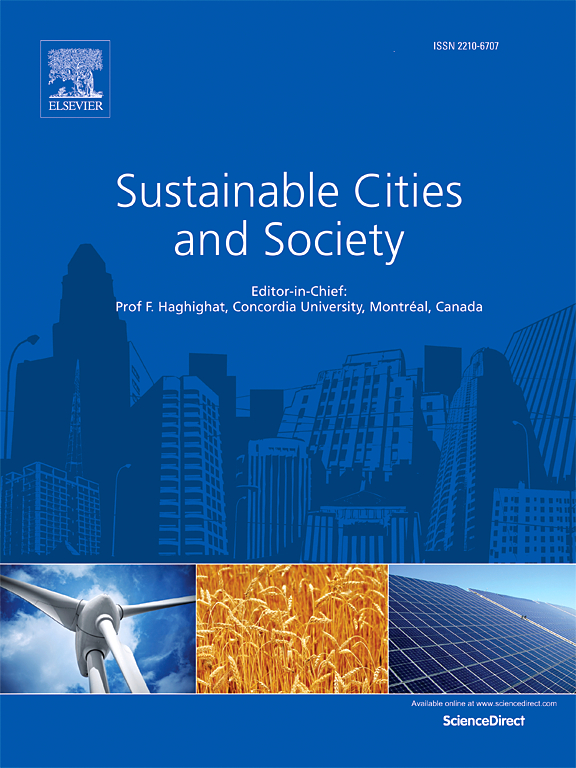A novel indicator for assessing spatial coupling relationships within hybrid landscapes comprising diverse land cover types and its application to explaining urban thermal environment
IF 12
1区 工程技术
Q1 CONSTRUCTION & BUILDING TECHNOLOGY
引用次数: 0
Abstract
This paper proposes a new indicator of spatial coupling degree (SC) to assess the spatial coupling relationships within the hybrid landscapes. The algorithm and calculation methodology for SC index was developed and investigated in two megacities of Zhengzhou and Wuhan. The coupling patterns and clustering features in hybrid landscapes were observed and quantified using the SC index and landscape pattern indices. Their linear and nonlinear correlations with land surface temperature (LST) were explored and explained through Spearman Correlation Analysis, Random Forest Model, and spatial association analysis conducted in Geoda software. The results indicated that the SC algorithm can be used to quantify the spatial coupling relationships within the hybrid landscapes across any range and scale. Enriching shared boundaries and balancing land cover areas both can enhance SC values. The SC values (SCbg, SCbf, SCbw, SCgf, SCgw, and SCfw) exhibited significant scale and regional differences, spatial heterogeneity, gradient variation, and local agglomeration. Complex correlations between landscape pattern indices, SC values, and LST values were observed. The proportion of dominant landscapes and their spatial coupling degree had a greater contribution and impact on LST. SCbg, SCbf, and SCgf showed distinct turning points, saturation values, and clustering features when explaining the thermal effects of these three types of hybrid landscapes. The index of SC could serve as a valuable supplement when measuring landscape patterns and environmental effects in the future. Different strategies should be adopted in different regions to optimize hybrid landscape patterns and further to improve urban thermal environment.
不同土地覆盖类型混合景观空间耦合关系评价指标及其在城市热环境解释中的应用
本文提出了一个新的空间耦合度(SC)指标来评价混合景观内部的空间耦合关系。以郑州和武汉两个特大城市为研究对象,研究了SC指数的算法和计算方法。利用SC指数和景观格局指数对混合景观的耦合模式和聚类特征进行了观察和量化。利用Geoda软件进行Spearman相关分析、随机森林模型和空间关联分析,探讨其与地表温度的线性和非线性相关关系。结果表明,SC算法可以在任意范围和尺度上量化混合景观内的空间耦合关系。丰富共享边界和平衡土地覆盖面积都可以提高SC值。SC值(SCbg、SCbf、SCbw、SCgf、SCgw和SCfw)表现出显著的尺度和区域差异、空间异质性、梯度变异和局部集聚性。景观格局指数、SC值和LST值之间存在复杂的相关关系。优势景观比例及其空间耦合度对地表温度的贡献和影响较大。SCbg、SCbf和SCgf在解释这三种混合景观的热效应时表现出不同的拐点、饱和值和聚类特征。该指数可作为未来景观格局和环境效应测度的一个有价值的补充。不同区域应采取不同策略,优化混合景观格局,进一步改善城市热环境。
本文章由计算机程序翻译,如有差异,请以英文原文为准。
求助全文
约1分钟内获得全文
求助全文
来源期刊

Sustainable Cities and Society
Social Sciences-Geography, Planning and Development
CiteScore
22.00
自引率
13.70%
发文量
810
审稿时长
27 days
期刊介绍:
Sustainable Cities and Society (SCS) is an international journal that focuses on fundamental and applied research to promote environmentally sustainable and socially resilient cities. The journal welcomes cross-cutting, multi-disciplinary research in various areas, including:
1. Smart cities and resilient environments;
2. Alternative/clean energy sources, energy distribution, distributed energy generation, and energy demand reduction/management;
3. Monitoring and improving air quality in built environment and cities (e.g., healthy built environment and air quality management);
4. Energy efficient, low/zero carbon, and green buildings/communities;
5. Climate change mitigation and adaptation in urban environments;
6. Green infrastructure and BMPs;
7. Environmental Footprint accounting and management;
8. Urban agriculture and forestry;
9. ICT, smart grid and intelligent infrastructure;
10. Urban design/planning, regulations, legislation, certification, economics, and policy;
11. Social aspects, impacts and resiliency of cities;
12. Behavior monitoring, analysis and change within urban communities;
13. Health monitoring and improvement;
14. Nexus issues related to sustainable cities and societies;
15. Smart city governance;
16. Decision Support Systems for trade-off and uncertainty analysis for improved management of cities and society;
17. Big data, machine learning, and artificial intelligence applications and case studies;
18. Critical infrastructure protection, including security, privacy, forensics, and reliability issues of cyber-physical systems.
19. Water footprint reduction and urban water distribution, harvesting, treatment, reuse and management;
20. Waste reduction and recycling;
21. Wastewater collection, treatment and recycling;
22. Smart, clean and healthy transportation systems and infrastructure;
 求助内容:
求助内容: 应助结果提醒方式:
应助结果提醒方式:


